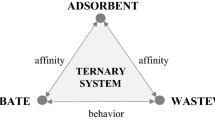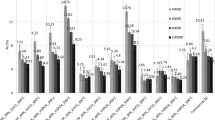Abstract
The study estimated the efficiency of Avocado seed carbon (ASC) for chemical oxygen demand (COD) and biochemical oxygen demand (BOD) reduction from coffee processing wastewater. It was performed under batch mode conditions to investigate the optimum operating conditions and efficiency for COD and BOD reduction with ASC compared with commercial activated carbon (CAC). Adsorption isotherm study was also performed and it was found that the values of regression coefficient (r 2), adsorption capacity (k), and adsorption intensity (1/n) for COD and BOD reduction with ASC were comparable to those of CAC. Under optimum operating conditions, the maximum percentage reduction of COD and BOD concentration using ASC was 98.28% and 99.19%, respectively and with CAC was 99.12% and 99.45%, respectively and hence adsorption capacity of ASC is comparable with that of CAC. Thus, this technique may be a good option for treatment of domestic wastewater.







Similar content being viewed by others
References
Adams, K. (1980). Coffee development and management techniques. Addis Ababa: Ministry of coffee and Tea development.
American Public Health Association (APHA), 1998. Standard methods for analysis of water and wastewater. 20th ed. Washington, DC.
Bhatnagar, A. (2007). Removal of bromophenols from water using industrial wastes as low cost adsorbents. Journal of Hazardous Materials, 139(1), 93–102.
Calvert, K. C. (1997) The treatment of coffee wastewater, the biogas option—a review and preliminary report of ongoing research. Coffee research report (50). Coffee industry corporation ltd. kainantu, Papua New Guinea.
Deepa, G. B., Chanakya, H. N., de Alwis, A. A. P., Manjunath, G. R., & Devi, V. (2002). Overcoming pollution of lakes and water bodies due to coffee pulping activities with appropriate technology solutions. In: Proceedings “Symposium on Conservation, Restoration and Management of Aquatic Ecosystems”, paper 4. Centre for ecological sciences, Indian Institute of Science (IIS) and the Karnataka Environment Research Foundation [KERF], Bangalore and commonwealth of learning, Canada.
Devi, R., & Dahiya, R. P. (2006). Chemical oxygen demand (COD) reduction in domestic wastewater by fly ash and brick kiln ash. J Water, Air and Soil Poll, 174(1–4), 33–46.
Devi, R., Dahiya, R. P., & Gadgil, K. (2002). Investigation of coconut coir carbon and sawdust based adsorbents for combined removal of COD and BOD from domestic wastewater, Water and Env. Manag. Series, International Water Association, 2002, 1209–1218.
Enden, V. J. C. (2002). Best practices at wet processing pay financial benefits to farmers and processors. GTZ-PPP Project on Improvement of coffee quality and sustainability of coffee production in Vietnam.
Enden, V. J. C., & Calvert, K. C. (2002). Limit environmental damage by basic knowledge of coffee waste waters. GTZ-PPP project-improvement of coffee quality and sustainability of coffee production in Vietnam. http://en.wikipedia.org/wiki/Coffee_wastewater.
Faust, S. D., & Aly, O. M. (1986). Adsorption process for water treatment (pp. 14–23). Stoneham: Butterworths.
Fresner, J., & Schnitzer, H. (1996). How coffee-making can help one understand cleaner production. Journal of Cleaner Production, 4(3-4), 213–217.
GTZ-PPP. (2002). Post harvest processing: Limit environmental damage by basic knowledge of coffee wastewater. http://www.venden.de/pdfs/coffee_waste_water_treatmentV4.pdf
Indian standard methods for determination of specific surface area of powders and porous particles using low temperature gas adsorption technique, IS-1986.
INEP. (2001). Bioreactors for clean coffee effluents–reducing water pollution in Western Ghat with appropriate technology solutions. http://www.inep-karnataka.org/pdfs/coffee.pdf and http://www.inepkarnataka.
Matos, D. T. A., Lo Monaco, P. A., Pinto, A. B., Fia, R., & Fukunaga, D. C. (2001). Pollutant potential of wastewater of the coffee fruits processing. Federal University of Viçosa, Department of Agricultural Engineering, Viçosa-MG, Brazil. http://www.ufv.br/poscolheita/aguas/artigos/Pollutant.
Mazumder, D., & Roy, B. (2000). Low cost options for treatment and reuse of municipal wastewater. Ind J Environ Prot, 20(7), 529–532.
Mckay, G., Otterburn, M. S., & Sweeney, A. G. (1980). The removal of color from effluent using various adsorbents—III silica: rate processes. Water Research, 14, 20–25.
Mendoza, B. R., & Rivera, C. M. F. (1998). Start-up of an anaerobic hybrid UASB⁄Filter reactor treating wastewater from a coffee processing plant. J of Anaerobe Env Microbiology, 4, 219–225.
MoEF (Ministry of Environment and Forest), 2003. Water (Prevention and Control of Pollution) Cess (Amendment) Act, 2003. Ministry of Environment and Forests, Government of India, New Delhi.
Mohammed, A., Akhtar, H. K., & Ahmad, A. (1998). Role of sawdust in the removal of copper (II) from industrial wastes. Water Research, 32(10), 3085–3091.
Murthy, N. K. V., Chandru, B. T., & Antonette D. S. (2003). Report on IEI’s Rural Electricity and Water Supply Utility (REWSU) project with special reference to the utility at Mavinakere. International Energy Initiative, Bangalore, http://www.iei-asia.org/IEIBLRREWSUReport.
Murthy, N. K. V., Antonette, D. S., & Kapur, G. (2004). An effluent treatment-cum-electricity generation option at coffee estates: is it financially feasible? Draft version. Bangalore: International Energy Initiative.
Pala, A., & Tokat, E. (2002). Color removal from cotton textile industry wastewater in an activated sludge system with various additives. Ind J Environ Prot, 36, 2920–2925.
Patnaik, S. N., Baisak, P. C., & Patnaik, L. N. (1996). Removal of COD from textile mills effluent using fly ash. Ind J Environ Prot, 591–594.
Piet, N. L., Piet, M. V., Lode, S., & Willy, H. V. (1994). Direct treatment of domestic wastewater by percolation over peat, bark and woodchips. Water Research, 28(1), 17–26.
Poots, V. J. P., McKay, G., & Healy, J. J. (1976). Removal of basic dyes from effluents using wood as an adsorbent. J Wat Poll Control Fed, 50, 926–935.
Rolz, C. (1982). Biotechnology in washed coffee processing. Process Biochemistry, 17(2), 8–10.
Sharma, N., & Sharma, R. (1994). Combined paper mill effluent treatment by Wateer hyacinth. Ind J Environ Prot, 14, 678–681.
Srivastava, V. C., Mall, I. D., & Mishra, I. D. (2005). Treatment of pulp and paper mill wastewaters with poly aluminium chloride and bagasse fly ash. Colloids and Surfaces. A, Physicochemical and Engineering Aspects, 260(1–3), 17–28.
Wang, S., & Wu, H. (2006). Environmental-benign utilization of fly ash as low-cost adsorbents. Journal of Hazardous Materials, 136(3), 482–501.
Wang, S., Li, L., Wu, H., & Zhu, Z. H. (2005). Unburned carbon as a low-cost adsorbent for treatment of methylene blue-containing wastewater. J Colloid and Inter Sc, 292(2), 336–343.
WHO. (1995). Guideline for discharge of industrial effluent characteristics. Geneva, 3, 231–236.
Author information
Authors and Affiliations
Corresponding author
Rights and permissions
About this article
Cite this article
Devi, R. Innovative Technology of COD and BOD Reduction from Coffee Processing Wastewater Using Avocado Seed Carbon (ASC). Water Air Soil Pollut 207, 299–306 (2010). https://doi.org/10.1007/s11270-009-0137-2
Received:
Accepted:
Published:
Issue Date:
DOI: https://doi.org/10.1007/s11270-009-0137-2




